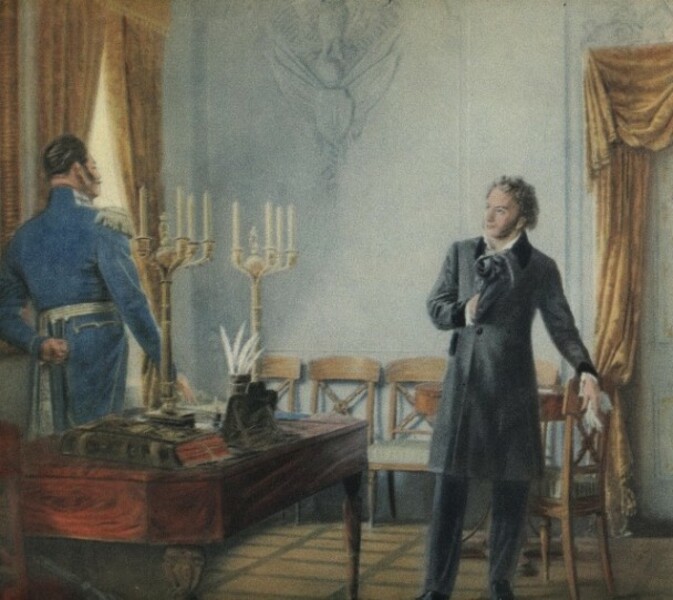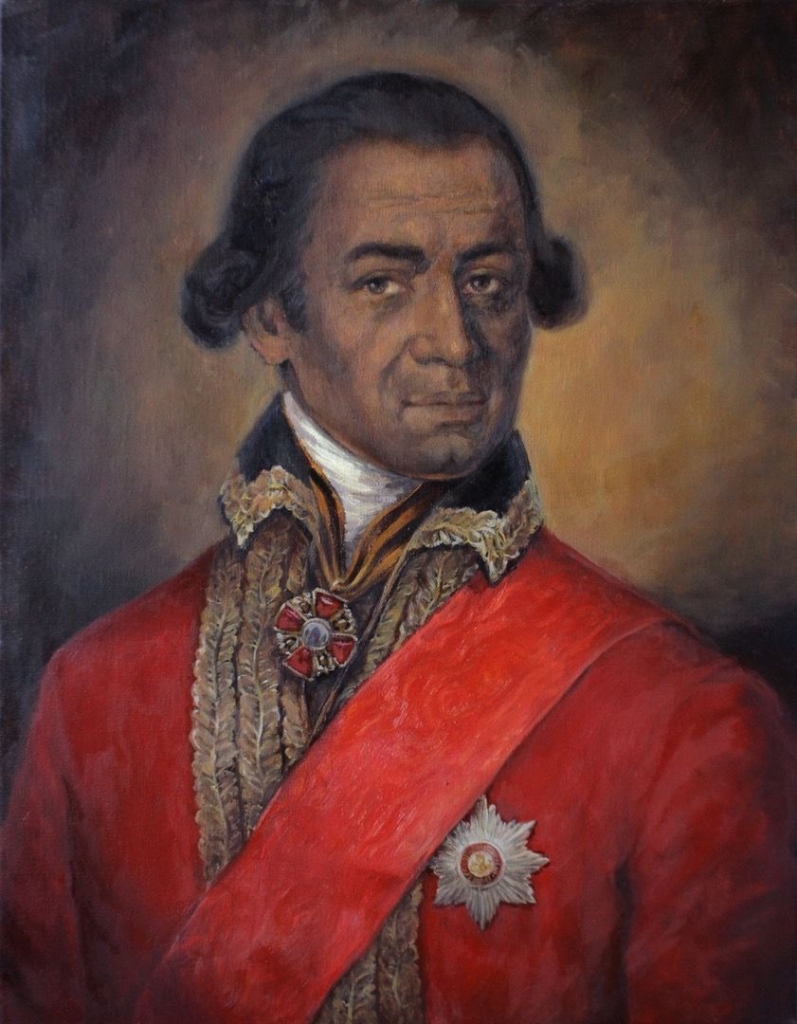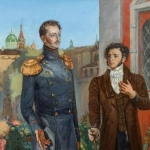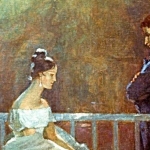
06.01.2023
Alexander Sergeevich could not see his great—grandfather – his great-grandfather died 18 years before his birth. But he met his two sons. They were his great-uncles. To Ibrahim’s eldest son, Ivan Hannibal, Pushkin was brought to meet at the age of one year in 1800, a few months before Ivan’s death.
With the second son of the Hannibals — Peter, who died in 1826, he repeatedly met. The conversations with him were very interesting, and he learned a lot from them about his African relatives.
But how could African Arap blood appear in the veins of the native Russian nobles? Probably, this should have been preceded by some mysterious dramatic story? Let’s give the floor to Pushkin himself, who was keenly interested in his ancestors.
He could ask old people, his grandmother, the wife of one of Hannibal’s sons, who died in 1818. He could use “family traditions”. His nanny, Arina Rodionovna, could tell him something, she was 23 when her great-grandfather died. Pushkin’s parents for some reason avoided talking about this topic. Maybe they were shy? Nevertheless , Pushkin in 1826 wrote a lengthy note to the first chapter “Eugene Onegin”. Informs him that he is of African descent on his mother’s side. His future great-grandfather, Ibrahim, was born in Ethiopia on the shores of the Red Sea. At the eighth year of life, the boy is kidnapped, put on a ship, taken by sea, by land, again by sea and brought to Istanbul — to the court of the Turkish sultan. Pushkin could not understand why the boy was taken away? But they explained to him that at that time children from the most noble families were brought to the supreme ruler of all Muslims. Ibrahim was the youngest of 19 brothers — the sons of one of the powerful, rich and influential Abyssinian princes. Abducted children became hostages who were killed or sold if their parents “behaved badly.”

In 1703, Ibrahim found himself in the capital of Turkey. A year later, he was abducted again and taken out by order of the Russian ambassador in Istanbul, Pyotr Andreevich Tolstoy. (It is curious that this Tolstoy is the great—grandfather of the great Leo Tolstoy.) Of course, all this was done secretly by order of Tsar Peter and for Peter himself. With all precautions, the boy is being transported overland through the Balkans, Moldova and Ukraine. This route seemed safer than the sea route through the Black and Azov Seas: there the Turks could overtake the fugitives.
But why did Tsar Peter need a dark-skinned boy? I must say that in those days it was “fashionable” to have a court Arab. Peter, not only for the sake of this fun, sent a secret instruction — “to get a better and more skillful Black boy.” He wanted to prove that black-skinned Arab boys are no less capable of science and business than many stubborn Russian youngsters. In other words, there was an educational goal here. At that time, Negroes were considered wild people. Tsar Peter broke prejudices and customs, he “valued heads according to abilities, and hands according to the ability to create things, and not according to the color of the skin!”
And now Ibrahim is being taken to Russia. On the way, he sees snow for the first time in his life! He arrived in Moscow on November 13, 1704. Then Pushkin writes: “The emperor baptized the boy Ibrahim in 1707 and gave him the surname Hannibal. At baptism he was named Peter. But since Ibrahim was crying and did not want to bear a new name, he was called Abram until his death.” (This is in tune with Ibrahim.) And by his patronymic he was called Petrovich — in honor of Peter. This is how Abram Petrovich Hannibal appeared in Russia. The famous Blackamoor of Peter the Great!
Ibrahim’s elder brother came from Abyssinia to St. Petersburg and offered Tsar Peter a ransom for him. But Peter kept his godson with him. He loved him. Until 1716, Hannibal was constantly with the person of the sovereign, slept in his lathe, accompanied him in all campaigns. But even in his old age, Ibrahim still remembered Africa, the luxurious life of his father, 18 brothers who were taken to their father with their hands tied behind their backs so that they “would not get used to encroaching on the power of their father.” He also remembered his beloved sister Lagan, sailing in tears from afar behind the ship on which he was taken away from Abyssinia.
In 1717, the tsar and his retinue, including the Arab, visited France. There they got acquainted with its sciences, art, generals and King Louis XV himself, who ascended the throne at the age of five and ruled the country for the second year. About this meeting, Peter amusingly writes to Empress Catherine I: “… I announce to you that last Monday I was visited by the local king, who is two fingers more than our dwarf, our child is a fair way and a camp and is quite reasonable in his age, who is seven years old.”
Abram Hannibal was left to study in Paris. Leaving a smart dark—skinned student in France – at the center of European culture, the tsar expected a lot from him. The tsar himself personally recommended him to the Duc de Men, a relative of the king and the chief of all French artillery. In Paris, Ibrahim studied at a military school and was released from it as an artillery captain. Then he joined the French army. During the Spanish War he distinguished himself at the front, but was seriously wounded in the head and returned to Paris. And, as Pushkin writes, “for a long time he lived in the scattering of the great light.” Peter I repeatedly called him to himself, but Hannibal was in no hurry, excusing himself under various pretexts.
The Parisian life fascinated Ibrahim. Ibrahim’s appearance in Paris, his appearance, natural intelligence and education (he knew four languages) aroused everyone’s attention. All the ladies wanted to see the “royal Blackamoor”. He was invited to fun evenings, he attended many dinners. And finally, the young officer fell in love. He was 27 years old. He fell in love not with anyone, but with a countess who was famous for her beauty. Her house was the most fashionable in Paris. She was going to have the color of Parisian society. And, as Alexander Sergeyevich writes, “the Countess gradually got used to the appearance of a young Negro. She liked his curly head, blackened among powdered wigs. Ibrahim did not wear a wig because of the wound on his head.” The Countess fell in love with Ibrahim!
But the tsar finally wrote a letter to his favorite, after which he immediately returned to St. Petersburg. Peter wrote to him that he “does not intend to force him and leaves him to his good will — to return to Russia or stay in France. But that, in any case, he will never leave his pet.” Hannibal, upset, immediately returned to St. Petersburg. The sovereign granted Hannibal to the bombardier company of the Preobrazhensky Regiment as a captain-lieutenant. Peter was her captain. It was in 1722.

Three years later, Tsar Peter dies. After his death, Hannibal’s fate changed. Since 1730, the country has been ruled by Peter I’s niece Anna Ioannovna. Together with her favorite Biron, she scares people with executions, torture, and exile. Historians write: “Dashing winds rocked a great country, took thousands of lives, erected and overthrew cheerful favorites.” They also fiercely attacked Pushkin’s great-grandfather. In Pushkin’s notes we read: “Menshikov found a way to remove him from the yard. Hannibal was renamed the majors of the Tobolsk garrison and sent to Siberia with the assignment to measure the Chinese Wall.” He was not given any serious instructions — about the “Chinese Wall” Pushkin writes ironically. But it is known that in Siberia, an experienced and conscientious engineer Hannibal built excellent fortifications.
Having learned about the fall of Menshikov, he voluntarily returned to St. Petersburg at the end of 1730. There, Field Marshal Minikh miraculously saves him and secretly sends him to the Revel village — thirty kilometers from present-day Tallinn, where, as Pushkin writes, “he lived in minute-by-minute expectation of arrest.” Nevertheless, Abram Hannibal enters the service there and for two years — from 1781 to 1783 – teaches at the garrison school in the fortress of Pernov, that is, in Pärnu. And then he spent seven years in the village.
We learn about the fate of Abram Hannibal again from Alexander Sergeevich’s notes: “When Empress Elizabeth ascended the throne in 1741, Hannibal wrote her the gospel words: ”Remember me when you come to your kingdom!””. Elizabeth immediately summoned him to the court, promoted him to brigadier and soon afterwards to major general and, finally, to general-in-chief. She granted him a dozen villages in the Pskov and St. Petersburg provinces. In the first — Zuyevo (this is the current village of Mikhailovskoye), Bor and Petrovsky. And in the second — Suidu, Kobrino and Thais. And also the village of Ragola, near Revel. In 80 years, some of them will become “Pushkin places”.
Under Elizabeth, Hannibal was the most important person of the empire. In 1732, he was one of the leaders of the engineering corps. All fortification works in Kronstadt, Riga, Pernovo, Peter and Paul and other fortresses are carried out “according to his reasoning.” Since July 4, 1756, he has been an engineer general, that is, the chief engineer of the country! The rank of general-in-chief assigned to him in 1759 is associated with this activity. He builds Kronstadt docks, Siberian fortresses, Tver canals and Estonian ports.
And yet, in June 1762, already under Peter III, Hannibal, full of strength, suddenly resigns prematurely. The favorites and upstarts who appeared tried to talk down to him and even shout at him! But he was not a man of such a disposition to endure it! In addition to building canals, houses, fortresses, Hannibal was especially good at doing one more thing — quarreling with his superiors. Abram Hannibal did not want to “sit”, he wanted to “do business”! His absolute honesty, conscientiousness and uncompromising attitude were especially evident under Elizabeth Petrovna. Pushkin wrote about him: “He is diligent, incorruptible and not a slave!”
Tired of complicated intrigues, he submitted his resignation in 1762. After retiring, he settles in his manor in Suida. He lived there for two decades in peace and quiet with his wife Christina, who was not only loved, but also respected by her wayward husband. She was intelligent, educated and well-mannered. At the end of the XVIII century, retired general-in-chief Abram Petrovich Hannibal was living out his days.




